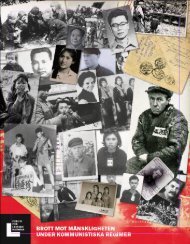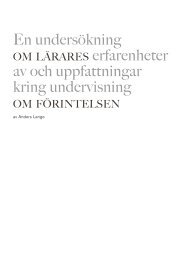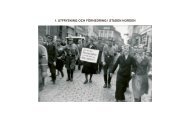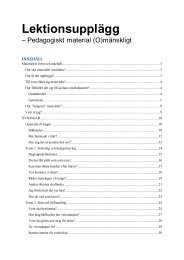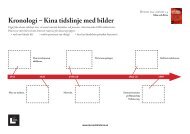Children…
Tell Ye Your Children... - Levandehistoria.se
Tell Ye Your Children... - Levandehistoria.se
- No tags were found...
Create successful ePaper yourself
Turn your PDF publications into a flip-book with our unique Google optimized e-Paper software.
The Holocaust in other parts of Europe<br />
Though the basic steps were always the same – identification,<br />
segregation, assembly, deportation and extermination<br />
– the Holocaust happened differently in every<br />
country where it occurred.<br />
Hungary was Germany’s ally, yet almost 1 million<br />
Jews, including refugees from other countries, remained<br />
physically safe there until 1944. Hungary passed anti-<br />
Jewish laws, but resisted German pressure to deport its<br />
Jews to the death camps. Everything changed in March<br />
1944, when Germany occupied Hungary. Deportations<br />
to Auschwitz began in mid-May. For 42 days,<br />
over 437,000 Jews were deported. Every day, up to<br />
12,000 people were gassed to death. Finally in early<br />
July, Regent Miklós Horthy ordered the deportations<br />
ended. Since these depended on Hungarian manpower,<br />
this order gave respite to some 200,000 Budapest Jews.<br />
Many received assistance from diplomats of neutral<br />
countries like Sweden, Switzerland and the Vatican.<br />
Yet, by December, some 30,000 Jews were killed, either<br />
during “death marches” to Austria or were murdered by<br />
members of the Arrow Cross (Hungarian Nazis).<br />
Fascist Italy, another German ally, also passed anti-Jewish<br />
“race laws”, but refused to deport its Jews.A senior minister<br />
told Mussolini, “We know the destiny of those Jews<br />
deported by the Germans. They are gassed. Everybody:<br />
women, old men, children. We want nothing to do with<br />
such evil deeds.” He demanded that Mussolini not allow<br />
any deportations.After Mussolini’s government fell in July<br />
1943, German troops and Italian antisemites deported<br />
some 8,000 of Italy’s 35,000 Jews to Auschwitz.<br />
Yugoslavia was divided after Germany’s April 1941<br />
occupation. About 80,000 Jews lived in the country,<br />
with most of Serbia’s 16,000 Jews in Belgrade.The Germans<br />
plundered their property and forced them into<br />
slave labour. In August 1941, most Serbian Jews were<br />
shot. In spring 1942, a mobile gas van was used at the<br />
Semlin concentration camp near Belgrade. By summer,<br />
only a few hundred Serbian Jews remained alive.<br />
Croatia’s new fascist Ustasha regime aligned itself<br />
with Germany, and its Jews were forced to wear the<br />
yellow star and had their property seized. The Ustasha<br />
systematically slaughtered Serbs, Jews and “Gypsies”. In<br />
Jasenovac concentration camp near Zagreb, tens of thousands<br />
of Serbs and “Gypsies” were murdered, as were<br />
some 20,000 of Croatia’s 30,000 Jews. By late October<br />
1941, most were dead, with 7,000 later deported<br />
to Auschwitz. In all, over 60,000 Yugoslavian Jews were<br />
murdered.<br />
Greece was occupied by both Germany and Italy.<br />
Until 1944, Jews in Italy’s zone were safe. In the German<br />
zone, Salonika’s Jewish community was virtually<br />
destroyed. From March to August 1943, some 44,000<br />
were deported Auschwitz, with only about 1,000<br />
returning to Salonika after the war. In the Greek islands,<br />
Jewish life was almost completely wiped out.<br />
Bulgaria, another German ally, resisted demands to<br />
deport its over 50,000 Jews. Hence, most survived the<br />
war. However, Bulgaria allowed Germany to deport<br />
Jews who were not citizens, mostly from Thrace and<br />
Macedonia. In total, more than 11,000 Jews were<br />
deported to Treblinka from territories controlled by<br />
Bulgaria.<br />
At the beginning of the war, over 750,000 Jews lived<br />
in Romania. In Bessarabia and Bukovina, some 160,000<br />
were starved or shot by Romanian troops aided by the<br />
Germans. Over 150,000 were deported to Transnistria,<br />
where most were killed along with local Jews. In central<br />
Romania, however, some 300,000 Jews survived.<br />
Despite Marshal Ion Antonescu’s anti-Jewish policies,<br />
for political reasons, the Romanians did not allow their<br />
remaining Jewish citizens to be deported.<br />
After Finland allied itself with Germany in June<br />
1941, a few dozen Jewish refugees and Soviet Jewish<br />
prisoners-of-war were handed over. Finland’s tiny Jewish<br />
minority was left unharmed.<br />
86



